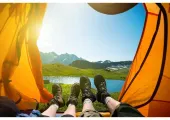A Guide to Camping Essentials
Catalogue
- Tents and Shelter
- Sleeping
- Cooking and Eating
- Safety Gear for Camping
- Clothing and Footwear
- Hygiene
- Tools and Equipment
- Recreational Items
- Electronic Devices
- Other Considerations
Show More
Tents and basic shelters come in all shapes and sizes these days. From small pup tents to multi-person portable shelters with fancy amenities. In order to find a tent that’s right for you, it’s important to consider where you plan to use it. Do you expect to go somewhere cold and windy? Is there are chance you’ll encounter a fair amount of rain? What is the general temperature difference between daytime and nighttime? Keep these considerations in mind as you look at your options. Another thing is whether you’ll be doing a lot of backcountry hiking away from your vehicle. If so, the overall weight of your equipment needs to factor into your planning. Invest in something lightweight and portable so you can save your energy and enjoy your time on the trail.

You know the old adage about “a good night’s sleep.” Just because you’re in the woods doesn’t mean you can’t enjoy feeling secure in your bed. The sleeping bag you choose should first and foremost reflect the conditions you expect to encounter. Make sure you get something with the appropriate temperature rating. Keep in mind here as well that you’ll have to carry it around. Paying a little extra for durability and portability is often worth it. Consider grabbing a foam pad for some additional support and elevation off the ground. Packing a separate pillow is an option, but you can also just use some spare clothing placed in a silk or nylon sack. Save a bit of money and weight.

Searching online you can find hours of video of people with sophisticated portable equipment whipping up dishes that look like they could garner a Michelin star. Then of course there are the Jeremiah Johnson-types who proudly show off their ability to hunt, trap, and cook their dinners from wild to table. For the rest of us, some basic knowledge and gear is all we require. Make sure as you’re heading out that you have the tools necessary for the task at hand. Matches or a trusty lighter are a must. Also, find some lightweight and durable utensils that you can wash and reuse. Avoid plastics or things that risk contaminating the surrounding environment. Pack a dish rag or sponge and some non-toxic soap you can use sparingly to disinfect your cookery. In terms of pots, pans, or portable stoves, these can be handy where you expect to spend several days in areas where it’s not possible to build a fire. As with all our other recommendations, everything you pack you will need to carry. Don’t overdo it.

No matter where you’re going, it’s always prudent to pack some safety gear just in case. Items that should be in anyone’s kit include a compass, safety pins, insect ointments to treat stings, alcohol swabs, sanitizer, adhesive bandages, and basic tools like tweezers. Depending on your destination as well as your individual requirements, you will likely need to pack additional materials. Don’t put yourself in the position where you become lost or stranded without the means to survive until help arrives. In cold weather conditions, this means having a thermal blanket as well as extra provisions for starting a fire. Be sure to have any medications you need plus a little extra in case of eventualities. Finally, always make sure at least someone knows where you are going and how long you intend to be gone. Arrange a check-in system if you plan to go backcountry or off trail.

Layers! Always dress in layers so that you can add or remove items as conditions change. Do a little research into the place you’re going and find local almanacs detailing things like average temperatures, rainfall amounts, and other weather patterns. Use these to help you plan what to bring. Expect that locations with high daytime temperatures may experience cool nights, particularly if you’re in an area with little to no cloud cover to trap ambient heat. Invest in good materials designed to wick moisture away from your body. Cottons and other moisture-trapping fabrics should be avoided. Pay special attention to climate conditions and assume it might get 5 to 10 degrees colder than you are expecting. Finally, pay careful attention to your foot health if you’re going to be doing a lot of walking. Make sure you protect yourself from cuts and abrasions, or the danger of rolling an ankle over rough terrain. This means a solid pair of hiking boots with good support, and good socks.

Multiday, backcountry excursions may provide limited access to facilities like showers or washrooms. In situations such as these, you will want to make sure you’re fairly self-contained as far as hygiene products. If you won’t have access to bathing facilities, pack biodegradable, non-toxic body wipes. When nature calls, be sure to have some environmentally friendly toilet paper on hand and make an effort to keep your waste away from trails or sources of water. When in doubt, dig a small hole and cover over anything you leave behind. Have a plastic bag or other sealable container for any products that need to be thrown away in the trash. Do not discard items willy-nilly. Sensible advice no matter where you’re camping is bring out everything you take in.

Having the correct tools can make the difference between a fun outdoor adventure and a downright frustrating experience. There are a few items you almost always want to have when camping. These include a reliable multi-tool. Look for something sturdier than the basic Swiss Army knife. It’s good to have at least a sharp blade a few inches in length, an assortment of screwing implements, and pair of plyers. Modern multi-tools will meet this requirement and have the durability needed. Consider a portable shovel or entrenching tool that can double as a hammer if you need to pound tent stakes into the ground. A roll of adhesive tape such as duct tape often comes in handy as does a length of thin nylon rope, which you can measure out as necessary.

Campsites are often the perfect place for recreational activities. Sports and games can be a fun way to pass the time together. It is relatively easy to find portable netting and a ball to allow yourself to easily construct a makeshift volleyball court. Naturally you can always bring some books or reading materials with you. We recommend you find a book on the local flora and fauna. Along with an inexpensive pair of binoculars, you can spend lots of time exploring your surroundings and learning to identify different animals, trees, or plants. Those interested in foraging should make sure their guides are accurate and locally-specific so as to avoid accidently finding or consuming unsafe plants or fungi.

Our modern lives are all consumed with electronic devices. Camping is a way for some people to enjoy leaving it all behind. For others, however, staying connected is an integral part of the experience. To that end, we recommend having some sort of portable recharging device with multiple input options. For example, look for a portable solar charger that also has a hand-crank option. You don’t want to be beholden an unreliable source of power. Keep in mind too that more remote parks and areas will have limited coverage options. If you absolutely need to keep in touch, you might need to shell out for a satellite phone; however, these can be prohibitively expensive. Finally, be sure to pack a rechargeable light source such as a headlamp. Modern LED varieties have an excellent power consumption to lumen ratio so you don’t need to carry lots of spare batteries.

A few non-equipment considerations to keep in mind include the following. National Parks and other public facilities tend to require reservations or permits in order to camp. These are often securable in advance and certainly something you want to look into before you arrive. The National Park Service has already indicated some parks and sites will operate at reduced capacity this season in order to prevent large groups of people from gathering. Securing your campsite in advance will likely be more essential than ever this year.

Camping is one of those activities where the simplicity can often be overwhelmed by the sheer amount of gadgets available nowadays. A walk through any outdoor equipment supplier will present with you myriad choices of things that all seem essential in the moment. Don’t fall victim to the temptation to over kit. Make a budget and give consideration to where you’re going, the local conditions, and add a little margin for error. If you cover the basics outlined in this article, you’ll be well on your way to backwoods proficiency in no time.
Trending Travelogues
Popular Trip Moments
Popular Travel Types
Popular Attractions
Popular Ranked Lists
Popular Destinations
Recommended Attractions at Popular Destinations
About













Site Operator: Trip.com Travel Singapore Pte. Ltd.







